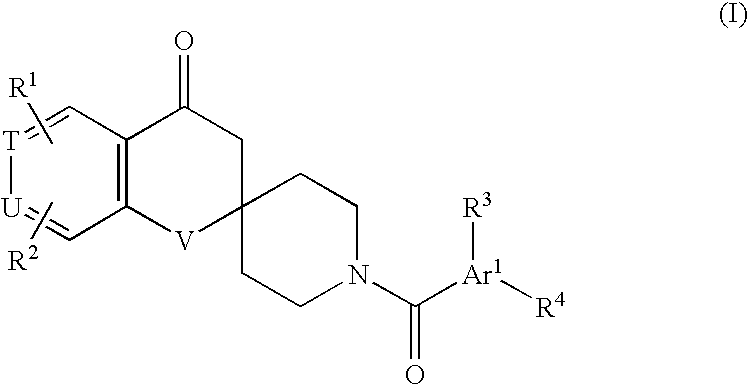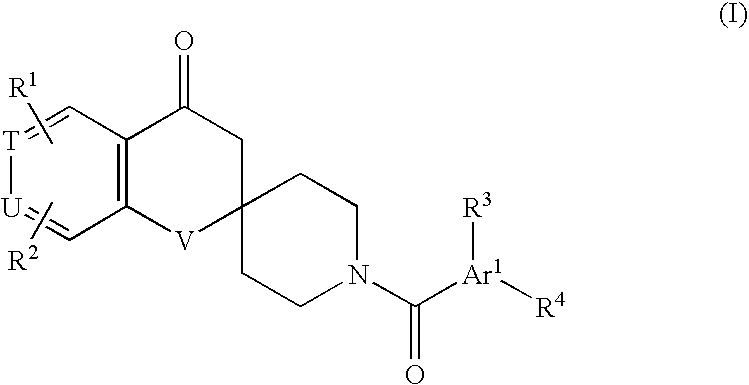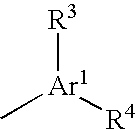Substituted spirochromanone derivatives
- Summary
- Abstract
- Description
- Claims
- Application Information
AI Technical Summary
Benefits of technology
Problems solved by technology
Method used
Image
Examples
example 1
1-[(1-Ethyl-4-methoxy-1H-benzimidazol-6-yl)carbonyl]-6-(1H-tetrazol-5-yl)spiro[chroman-2,4′-piperidine]-4-one
[0345]
[0346]A TFA salt of 3-ethyl-7-methoxy-3H-benzimidazole-5-carboxylic acid methyl ester (182 mg, 0.523 mmol) was dissolved in THF (3 mL) and MeOH (3 mL), aqueous 5 N sodium hydroxide solution (0.52 mL, 2.62 mmol) was added thereto and stirred at room temperature for 2 hours and at 60° C. for 1 hour. This was cooled to room temperature, then 5 N hydrochloric acid (0.55 mL, 2.75 mL) was added thereto, the solvent was evaporated under reduced pressure, and this was azeotroped twice with methanol and once with toluene to obtain a white solid. This material was dissolved in DMF (4 mL) and water (1 mL), and 6-(1H-tetrazol-5-yl)spiro-[chroman-2,4′-piperidin]-4-one hydrochloride (202 mg, 0.628 mmol), triethylamine (0.21 mL, 1.57 mmol), HOBT (106 mg, 0.785 mmol) and EDCI HCl (151 mg, 0.785 mmol) were added thereto. The reaction mixture was stirred at 90° C. for 2 hours, then coole...
example 2
1′-[(3-Cyclopropyl-8-methoxyimidazo[1,2-a]pyridin-6-yl)carbonyl]-6-(1H-tetrazol-5-yl)spiro[chroman-2,4′-piperidin]-4-one
[0347]
[0348]Methyl 3-cyclopropyl-8-methoxyimidazo[1,2-a]pyridin-6-carboxylate (30 mg, 0.122 mmol) was dissolved in THF (1.5 mL) and MeOH (1.5 mL), and added by aqueous 5 N sodium hydroxide solution (0.12 mL, 0.609 mmol), then stirred at 60° C. for 2 hours. This was cooled to room temperature, added by 5 N hydrochloric acid (0.12 mL, 0.609 mL), concentrated under reduced pressure, and then azeotroped with toluene. The residue was dissolved in DMF (2 mL) and water (0.5 mL), and 6-(1H-tetrazol-5-yl)spiro[chroman-2,4′-piperidin]-4-one hydrochloride (47 mg, 0.146 mmol), triethylamine (0.026 mL, 0.183 mmol), HOBT (25 mg, 0.183 mmol) and EDCI HCl (35 mg, 0.183 mol) were added thereto. The reaction mixture was stirred at 90° C. for 2 hours, then cooled to room temperature, and water was added thereto. The precipitated solid was collected by filtration, and dried under redu...
example 3
1′-[(1-Cyclopropyl-4-methoxy-1H-indol-6-yl)carbonyl]-6-(5-oxo-4,5-dihydro-1,2,4-oxadiazol-3-yl)spiro[chroman-2,4′-piperidin]-4-one
[0349]
[0350]Et3N (58 μL), HOBT (32 mg) and WSC (40 mg) were added to a solution of 1-cyclopropyl-4-methoxy-1H-indol-6-carboxylic acid (40 mg) and 6-(5-oxo-4,5-dihydro-1,2,4-oxadiazol-3-yl)spiro[chroman-2,4′-piperidin]-4-one hydrochloride (70 mg) in DMF (4 mL), and stirred overnight at room temperature. Water was added to the reaction mixture, and the formed solid was collected by filtration. The solid was washed thoroughly with water and ether. This was dried under reduced pressure to obtain the title compound. 1H-NMR (400 MHz, DMSO-d6) δ: 12.91 (1H, brs), 8.20 (1H, d, J=4.0 Hz), 8.00 (1H, dd, J=8.0, 4.0 Hz), 7.36-7.26 (2H, m), 7.22 (1H, s), 6.57 (1H, s), 6.39 (1H, d, J=4.0 Hz), 4.20-4.00 (1H, m), 3.87 (3H, s), 3.46-3.40 (1H, m), 3.40-3.20 (3H, m), 2.89 (2H, s), 2.06-1.77 (4H, m), 1.07-1.03 (2H, m), 0.94-0.90 (2H, m); MS [M+H]+=515.
PUM
| Property | Measurement | Unit |
|---|---|---|
| Pharmaceutically acceptable | aaaaa | aaaaa |
Abstract
Description
Claims
Application Information
 Login to view more
Login to view more - R&D Engineer
- R&D Manager
- IP Professional
- Industry Leading Data Capabilities
- Powerful AI technology
- Patent DNA Extraction
Browse by: Latest US Patents, China's latest patents, Technical Efficacy Thesaurus, Application Domain, Technology Topic.
© 2024 PatSnap. All rights reserved.Legal|Privacy policy|Modern Slavery Act Transparency Statement|Sitemap



